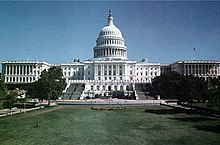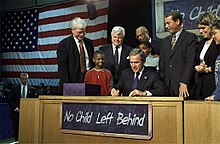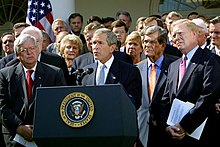
Back كونجرس امريكا ال107 ARZ 107. Kongress der Vereinigten Staaten German 107e congrès des États-Unis French Kongres Amerika Serikat ke-107 ID 107º Congresso degli Stati Uniti d'America Italian 107e Amerikaans Congres Dutch 107.º Congresso dos Estados Unidos Portuguese 第107届美国国会 Chinese
| 107th United States Congress | |
|---|---|
106th ← → 108th | |
 United States Capitol (2002) | |
January 3, 2001 – January 3, 2003 | |
| Members | 100 senators 435 representatives 5 non-voting delegates |
| Senate majority | Democratic (with tie-breaking VP) (until January 20, 2001) Republican (with tie-breaking VP) (Jan 20, 2001 – Jun 6, 2001) Democratic (through caucus) (from June 6, 2001) |
| Senate President | Al Gore (D)[a] (until January 20, 2001) Dick Cheney (R) (from January 20, 2001) |
| House majority | Republican |
| House Speaker | Dennis Hastert (R) |
| Sessions | |
| 1st: January 3, 2001 – December 20, 2001 2nd: January 23, 2002 – November 22, 2002 | |




The 107th United States Congress was a meeting of the legislative branch of the United States federal government, composed of the United States Senate and the United States House of Representatives. It met in Washington, D.C., from January 3, 2001, to January 3, 2003, during the final weeks of the Clinton presidency and the first two years of the George W. Bush presidency. The apportionment of seats in this House of Representatives was based on the 1990 United States census.
The House of Representatives had a Republican majority throughout the session, while the Senate was tied 50–50 for only the second time in history resulting in numerous changes in the majority. Vice President Al Gore gave Democrats a majority for 17 days, then a Republican majority after Dick Cheney became Vice President on January 20, 2001. Senator Jim Jeffords (R-VT) became an independent who caucused with the Democrats on June 6, 2001, giving the party a 51–49 majority for the rest of the Congress.
When Bush was sworn in as president on January 20, the Republicans held a federal trifecta for the first time since the 83rd Congress in 1955.
Cite error: There are <ref group=lower-alpha> tags or {{efn}} templates on this page, but the references will not show without a {{reflist|group=lower-alpha}} template or {{notelist}} template (see the help page).